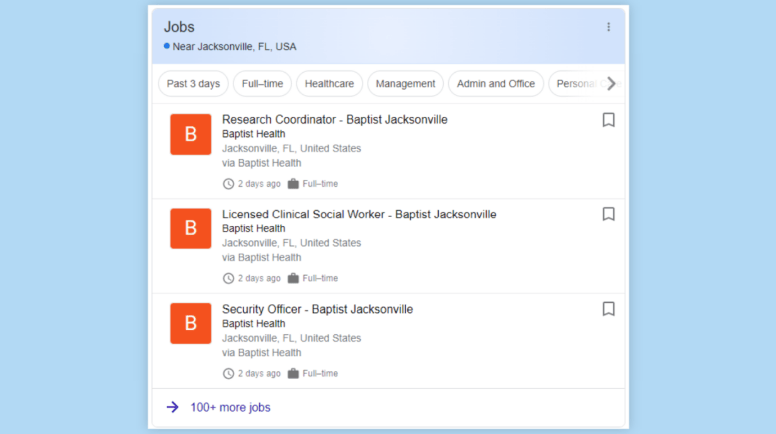Do you feel like your business gets lost on Google’s search engine results page (SERPs) even though you’ve invested heavily in search engine optimization (SEO)? If so, consider elevating your SEO strategy by leveraging Schema Markup!
Not sure what Schema Markup is? Read our guide on “What is Schema Markup” before exploring its benefits.
What are the Benefits of Schema Markup?
When your pages contain Schema Markup, it allows search engines and AI-powered machines to gain a deep, semantic understanding of your website content, which offers a host of SEO-related benefits for your business.
Schema Markup also enables search engines to display your content as a rich result under certain circumstances. These rich results are displayed prominently on the SERP and include extra information about a page, like ratings and reviews of local businesses.
However, as rich results come and go, the one thing that remains consistent is the semantic value of Schema Markup.
Here are some of the top benefits of Schema Markup.
1. Help Search Engines Better Understand Your Content
Humans are great at inferring the meaning of online content. Google, on the other hand, has to teach its tech to understand your content using machine learning.
That’s why search engines need extra help interpreting the meaning and intent of your site content. You can assist them by adding semantic Schema Markup to your web pages.
Schema Markup is a standardized vocabulary developed by Google, Yandex, Yahoo, and Bing. As such, these search engines can easily interpret the Structured Data on your page, allowing the algorithms to present users with content that better aligns with their search intent. It also helps search engines be more efficient because their machine learning and algorithms are built to understand Schema Markup.
2. Build a Content Knowledge Graph and Reuse It Within Your Organization
At Schema App, we go beyond generating Schema Markup. Using our advanced semantic technologies, we create connected Schema Markup to build a reusable Content Knowledge Graph. This Knowledge Graph can inform search engines and train large language models (LLMs) with precise, context-rich data about your organization.
When you implement connected Schema Markup, you are defining the objects in your content as individual entities with their own properties and relationships to other entities. Once defined, these entities can be connected with the people, places, things and concepts that other authorities have described like Wikipedia, Wikidata, and Google’s Knowledge Graph. Your Schema Markup can even enhance your Google Knowledge Panel in search.
A Content Knowledge Graph built with Schema Markup helps search engines better understand the relationships between your content, your organization, and external entities across the web. With this deeper understanding, search engines can infer new insights, delivering more accurate and contextual search results.
At Schema App, we implement semantic Schema Markup and entity linking to assist customers in developing their Content Knowledge Graph. This Content Knowledge Graph enables search engines to effectively match your page with user search queries, driving higher qualified traffic and boosting click-through rates.
3. Be AI-Search Ready
Search engines are increasingly relying on artificial intelligence (AI) to provide users with more relevant answers to their queries. By implementing Schema Markup, you can enhance search engines’ understanding of your content. This, in turn, enables them to accurately match your content with your target audience, ensuring a more precise and effective user experience.
In Google’s podcast titled, “Structured Data, What’s it all about?”, Ryan Levering shared how machine learning and structured data go hand in hand. When you take into consideration that machine learning is the building block for AI, an action you can take to prepare for more AI in search (such as Bard and ChatGPT) is to adopt structured data to inform the machine learning about your content and have it be fully understood.
By using semantic Schema Markup to develop your Content Knowledge Graph, AI can tap into this resource and be grounded in more context. This provides them with a richer understanding of your brand and its associated entities.
Simply put, by developing your Content Knowledge Graph, you’re creating AI search-ready content.
4. Control How Your Brand Appears in Search
Adding Schema Markup to your web pages lets you exercise greater control over your brand’s appearance in search, empowering you to shape and manage your brand image. One of the key advantages of implementing Schema Markup lies in its capacity to establish a robust control point within your Content Knowledge Graph, by enabling you to communicate essential information about your organization and entities directly to AI search engines.
Without structured data, search engines rely on algorithms to infer details about your business, which can lead to inaccuracies and misunderstandings. However, with Schema Markup, you take the reins, grounding and informing the AI systems with precise, structured data. By doing so, you mitigate the risk of search engine “hallucinations” – where the algorithms misinterpret or misrepresent your brand.
Imagine your website displays two prices for the same product: one for members and another for non-members. Left unchecked, AI search engines might not recognize the difference, potentially displaying incorrect information in the SERP.
This lack of differentiation can severely impact the trustworthiness and clarity of your brand. However, by clearly indicating which pricing you want displayed using Schema Markup, you can accurately communicate these distinctions, guiding search engines to present the correct pricing information to the users.
Schema Markup is your safeguard against such discrepancies, ensuring your brand and products are accurately represented and preventing any potential confusion for users.
5. Help You Stand Out in Search With Rich Results
When Google understands your Schema Markup, it can use this data to show your content as a rich result (also known as rich snippets) on the SERP.
A standard search result will deliver a title, URL, and meta description. However, rich results include captivating images that draw users’ eyes to your search result and web page.
In total, Google has more than 32 different types of rich results. You can classify your content as local business content, recipes, articles, event pages, and more. If you’re promoting an event, you can improve its visibility by adding Event Structured Data, making your page eligible to appear in the event experience section on Google.
Once you add Schema Markup to your page, you can use Google’s rich results test to see which rich result your page is eligible for. We also suggest using the Schema Markup Validator on Schema.org to detect any mistakes in your Structured Data.
If you want to ensure that your Schema Markup efforts align with your overall branding strategy, here are some examples of rich results you can consider using.
Review Snippets
Review snippets provide prospective customers with reviews and ratings from your past customers and help improve your brand’s credibility in search results.
Product
Product rich results reveal sought-after details like pricing, availability, etc. You can generate more leads and increase interest in your product offerings by providing consumers with this information on the SERP. Beyond the fundamentals, you can also expand your Product rich result to include price drops, ratings, reviews, shipping details and more.
6. Drive Business Results
Schema Markup is an SEO strategy that can provide your company with measurable results and a strong return on investment.
You can use tools like Google Search Console and Schema Performance Analytics to closely monitor how your newly marked-up pages are performing.
When implemented strategically, Schema Markup can:
- Help ensure that your content appears in search results for highly relevant queries. This means that the traffic you receive is more likely to be interested in your products or services, which leads to increased CTR and an overall higher likelihood of conversion and engagement.
- Make your search results more appealing and informative to users, leading to higher CTR. Rich results can provide users with additional information about your content, such as star ratings, prices, and product availability, making them more likely to click your link.
- Be particularly beneficial for local businesses. By marking up local business information, you can improve your visibility in local search results and map listings, driving foot traffic to your physical locations.
Achieving robust results with Schema Markup isn’t unusual. At Schema App, we’ve seen customers across a wide range of industries achieve great results with this SEO strategy.
For instance, SAP saw a 400% growth in clicks from rich results after working with our team, and Sharp Healthcare enjoyed an 843% increase in clicks in just nine months.
As more businesses recognize the benefits of Schema Markup, implementing it can give you a competitive edge. Your content will stand out in search results and provide a more comprehensive, informative, and trustworthy experience to users.
7. Attract Job Applicants
You can incorporate Schema Markup into job postings to help attract quality talent. By applying Structured Data to your job listing pages, your job posting will be eligible for display among Google’s job search experience results.
Top listings are displayed at the top of the SERP. If your listings make the cut, they’ll feature reviews, ratings from past employees, job details, and your company logo.
8. Improve Your Content Strategy
Chances are that you’re already investing heavily in creating SEO content, optimizing it for priority keywords, and engaging in other on-page SEO tactics to rank higher on the SERP. Unfortunately, your competitors are likely doing the same.
Fortunately, you can beat the competition and inform your content strategy by utilizing Schema Markup. Thinking about your content from the perspective of the rich results you want to achieve can help to generate ideas for new content or existing content. If you want your page to be eligible for a Review Snippet, you can improve your content by adding customer reviews and ratings on your site.
Start by looking at Google’s Structured Data Guidelines, then generate the required Schema Markup using Google’s Structured Data Markup Helper or our Schema App Editor. Once you’ve generated the markup, you can add the Schema Markup to your pages so your content can stand out as a rich result.
You can go one step further to create connected Schema Markup by linking the topic covered in your content to the Wikipedia or Wikidata page for the specific topic within your Schema Markup.
Read our step-by-step guide to learn how to develop a Schema Markup strategy for your website.
While Schema Markup can support content strategy from the perspective of rich results and structured data guidelines, your Knowledge Graph can help you optimize your content strategy through offering high-level analysis of your content library.
Learn more by reading “How to Drive Your Content Marketing Strategy Using Content Knowledge Graphs“.
Start Implementing Schema Markup Today
The benefits of Schema Markup are undeniable.
When you add Schema Markup to your website, you’ll help search engines understand your content and make your pages more visible in organic search. In turn, you’ll increase your click-through rates and generate more organic traffic for your web pages.
Any business with an online presence can generate measurable results using structured data. However, to tap into the full potential of Schema Markup and stand out online, you must build, manage and optimize it as part of your ongoing site strategy. Otherwise, you’ll encounter issues like Schema Drift which hinder your ability to achieve rich results.
The good news is you can streamline the implementation and management of your Schema Markup by working with Schema App. We work with enterprise SEO teams to fully leverage the benefits of Schema Markup. Get in touch with us today to learn more.





